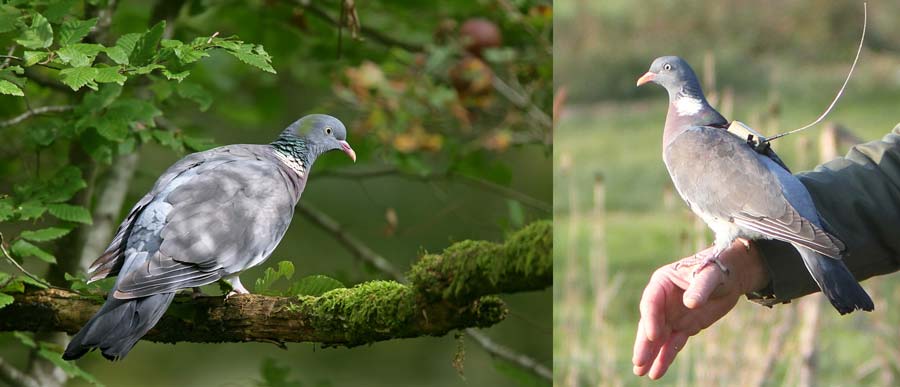← Back
Common Woodpigeons keep their breeding sites, change their wintering ones

Tracking animals help in understanding their behaviour, which can benefit to their protection, even for abundant species such as the common woodpigeons. Their behavioral plasticity, demonstrated by such study should help them in maintaining their population.
The common woodpigeon (Columba palumbus) is a very abundant and widespread species, breeding throughout Europe, northern Africa and parts of Asia. The population has grown and expanded to urban areas, with the result that it is now one of the most common birds in many European towns.
It is considered as a migratory species. However, regarding the migratory strategies, individuals can be either strictly migratory, partially migratory or resident. The different breeding areas seem to be linked to those three strategies. E.g., woodpigeons breeding in Western Europe are mainly residents, while most Central European individuals are expected to be partial migrants, and populations from Eastern Europe and Fennoscandia to be strictly migratory. The foraging behaviour is also suspected to depend on the regions, and to vary throughout the year.
In order to check these hypotheses, a study used ringing recoveries, Argos satellite tracks from individuals tagged during the winter in France and Portugal, and GPS tracks from individuals tagged at their breeding sites in Germany and Portugal.
Tracking common woodpigeons by Argos
Twelve woodpigeon tracks, equipped with Argos transmitters (PTT non-solar or solar tags) in France (11 individuals) and Portugal (1 individual) during the wintering (non-breeding) season, were analysed.
The equipped woodpigeons departed for spring migration on average on 13 March and arrived at the breeding sites on 7 April. On average, they made one stopover lasting nearly 9 days during spring migration. Breeding sites were located in the German federal states of Bavaria (4 individuals), Baden-Württemberg (1), Rhineland-Palatinate (1), Thuringia (1), Lower Saxony (1), and North Rhine-Westphalia (1), as well as in Switzerland (1).
![Tracks of twelve woodpigeon equipped with Argos transmitters (PTT non-solar or solar tags) in France (11 individuals) and Portugal (1 individual) during the wintering (non-breeding) season (from [Schumm et al., 2022])](https://www.argos-system.org/wp-content/uploads/2022/12/114_2022_1812_MOESM1_ESM-11fig.png)
Tracks of twelve woodpigeons equipped with Argos transmitters (PTT non-solar or solar tags) in France (11 individuals) and Portugal (1 individual) during the wintering (non-breeding) season (from [Schumm et al., 2022])
For five Woodpigeons, data transmission lasted beyond the first breeding season after transmitter deployment. This enabled to estimate breeding and wintering site fidelity for those individuals. Three out of four used two distinct wintering sites on their second wintering period. The use of several wintering sites for the others Argos-tagged birds is difficult to assess, since the tagging took place at the end of the wintering period, thus shortening the time in which site switches could have occurred.
Higher resolution (GPS) data around Lisbon (Portugal) and Giessen (Germany) were also analysed with respect to land cover use, to study the foraging strategies of urban birds. While the Lisbon woodpigeons were clearly residents of an urban green area, the ones from Giessen foraged in the countryside, and some migrated, resulting in fluctuating numbers of individuals depending on the year.
Fluctuating numbers of woodpigeons were also recorded at French, Spanish and Portuguese (other than Lisbon) wintering sites. The use of multiple wintering sites may follow the availability and accessibility of food resources. For example, a shift to wintering sites to South-Western France was associated with the intensification of maize monoculture there.
The woodpigeons thus seem to exhibit a low wintering site fidelity, but to be faithful to their breeding sites. This reveals a pronounced plasticity in migration and foraging behaviour at the species as well as at the individual levels. This observed plasticity in individual migratory decisions, suggests that migratory strategy in Woodpigeons is unlikely to be strictly and solely genetically fixed.
Reference & links
- Schumm, Y.R., Masello, J.F., Cohou, V. et al. Should I stay or should I fly? Migration phenology, individual-based migration decision and seasonal changes in foraging behaviour of Common Woodpigeons. Sci Nat 109, 44 (2022). https://doi.org/10.1007/s00114-022-01812-x
- https://www.gifs-france.com/
- An article on the same project is in an Argos Forum
Main Photo: Woodpigeon without and with an Argos PTT (credit resp. Dominique Gest and François Sabathé)
